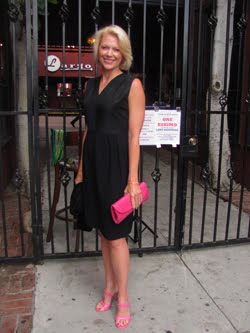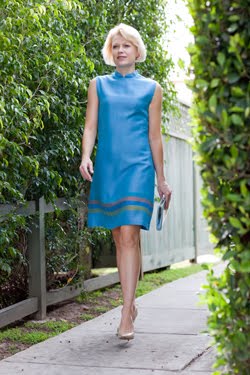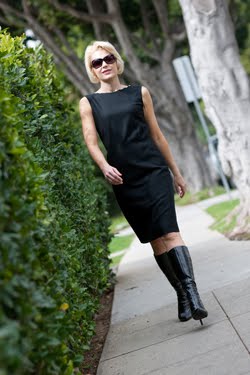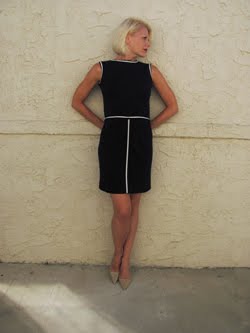Last Saturday was the second in my STYLE OF SIN series at the American Cinematheque, and it was focused on the Queen of Pre-Code herself - Kay Francis. I spoke all about the Production Code, Kay's life and career, and then the backstories of our double feature Girls About Town (1931) and Jewel Robbery (1932). Trouble in Paradise (1932) was also a critical success for Kay in both film and fashion, so I did share some of that in the presentation. But I felt it was important to share even more with you - both for those who came to the event and for those who missed it. I hope you enjoy this article I wrote for GlamAmor a few years ago.
-----
Elegant. Sophisticated. Continental. Sensual. Stylish. All of these adjectives have been used to describe Ernst Lubitsch's Trouble in Paradise (1932). A Pre-Code classic with its suggestive sexual situations, the film looks at love and lust between its leads in exotic European locales like Venice and Paris. Films of the 1930s offered an escape for Depression era audiences and many movies took their lead from this romantic comedy, which set the standard for those to come. Top Hat (1935) and My Man Godfrey (1936) are but two that owe something to Paradise. It effortlessly evokes a mood as effervescent as the "moon in champagne" (a line from the film) and is the first from the director to be described as having the "Lubitsch Touch." Much of the reason that the movie is so magical is its costume design and his collaboration with the legendary Travis Banton. Not only is Trouble in Paradise a shining example of Lubitsch and his vision but, as you will see, the embodiment of Banton's own iconic style.
Though many may have heard of the "Lubitsch Touch," few today know the man. Surprising, even shocking, given he is revered like no other among great film directors. Frank Capra, John Ford, Orson Welles, Joseph Mankiewicz, and Peter Bogdonovich are only the start of a very long list. Each represents a different cinematic view and yet all hold Lubitsch in the highest regard. In addition to defining what romantic comedy could and should be, Lubitsch largely defined what all movies could and should be. Director Jean Renoir credited him with creating the "modern Hollywood" since, with him, the look and stories of film shifted from the early D. W. Griffith model of moviemaking into much of what we take for granted today. His structure and artistic choices were so admired that director Billy Wilder even had a sign on his office wall that asked "What would Lubitsch do?"
What Lubitsch did was have a vision and work with great artists who shared it. First and foremost was his screenwriter Samson Raphaelson. The two were so close that Raphaelson would often weigh in on directing decisions while Lubitsch would also play with parts of the script. A frequent feature of theirs was the love triangle, which one can see somewhat in Ninotchka (1939) and of course the scandalous Design for Living (1933). The scandal started with Trouble in Paradise, though, with its strong sexual innuendo. Even the opening credits - with a bed floating behind the title - caused a stir. Because the Production Code was not yet fully enforced, the movie managed to squeak past the censors when it premiered. But by 1935, when the Code had its teeth, Paradise was prohibited from being distributed and would not be seen again until 1967. This has made Trouble in Paradise a lesser known film even among classic cinema fans, an oversight that many historians are now trying to make right.
Though Lubitsch is indeed great, the reason that Trouble in Paradise made my elite list of The Style Essentials is due to another talent - Travis Banton (above). The film is a virtual fashion show of the style he was known for best. Banton started his career in couture - first at Hattie Carnegie, then Madame Frances, and finally at Lucile. It was at Madame Frances that Mary Pickford chose one of his wedding gown designs for her wedding to Douglas Fairbanks in 1920. Not surprisingly, Banton became internationally known and Paramount's head costume designer Howard Greer (another Lucile alum) brought him to the studio. Though Banton would have an early success with Clara Bow in It (1927), the film's flapper fashion was not really indicative of his signature design style. He was a visionary already looking toward the 1930s.
A major shift in fashion was happening at that time courtesy of Madeleine Vionnet, a couturier who broke new ground in the late 1920s with her invention of the bias cut. This means that, for the first time, fabric was cut at a 45 degree angle (rather than straight along the grain) which allowed any fabric a certain amount of stretch. Designs that used the technique seductively hugged the curves of the female form. Though the bias cut started in Europe with Vionnet, the style's popularity soared and has became synonymous with the 1930s largely because of two Americans - costume designers Adrian at MGM (see 1933's Dinner at Eight, for example) and Banton at Paramount. Banton especially favored a long and lean silhouette and truly mastered the art of the bias cut. He used it extensively on friends like Marlene Dietrich - Shanghai Express was filmed the same year as Paradise - and Carole Lombard. One star of the era who was particularly associated with the bias cut was Kay Francis.
Kay was a superstar of the 1930s and consistently glamorous in all of her roles, thanks to Banton as well as Orry-Kelly at her new home studio of Warner Bros. To fuel the fantasy of Depression weary audiences, Banton dressed Kay in sleek gowns that really pushed the limits of how bare a girl could go. She was known for wearing designs with deep décolletage in the front and back, often at the same time. Her body conscious slip and tank dresses were surprisingly modern, and would also later influence much of the minimalist style of the 1990s. Trouble in Paradise is one of the movies that best showcases her own signature style and many of the looks from the film are still influential in fashion. As you can see in a relatively recent Cinema Connection, designers like Ralph Lauren and Michael Kors continue to reference Kay in Banton's bias cut in their collections today.
For those who love films from the 1930s, and particularly the Pre-Code genre, Ernst Lubitsch's Trouble in Paradise is intoxicating. It's so light and lovely - as much an escape for those of us who suffered the Recession as it was for audiences during the Depression. The chemistry between the actors is amazing; though you may see nothing of sex, you do nothing but feel it through the entire production. Some of this was due to an actual attraction between its stars, but of course Travis Banton's costume design also does much to assist this. Both Kay and co-star Miriam Hopkins slink around the dazzling Art Deco sets (and Herbert Marshall) in little more than slips of silk over their fantastic figures. Though still being rediscovered today, Trouble in Paradise is essential to see both as a groundbreaking romantic comedy and how it features the forefront of 1930s fashion that is still inspiring design today. Enjoy the escape.
At the opera, Gaston (Herbert Marshall) spots Mariette (Kay Francis) -
and her expensive clutch - through his binoculars
As Mariette searches for her lost handbag,
we can admire her gorgeous bias cut gown with fur-trimmed wrap
Criminals never looked so good...
pickpocket Lily (Miriam Hopkins) strikes a pose in gold lame bias cut
Gaston devours Lily with his gaze - from the top of her head to her bottom -
and his lust for her becomes equally matched by feelings of love
Mariette meets Gaston in her search for her lost clutch in a fur-trimmed bias cut gown
and decides to hire her new infatuation as her secretary
Banton was associated with the phrase "When in doubt, trim in fur" because he so loved it -
mentor Lady Duff Gordon did it first and then
it was encouraged by Paramount head Adolph Zukor, a former furrier
it was encouraged by Paramount head Adolph Zukor, a former furrier
Gaston, in turn, hires Lily as his secretary
and the love triangle is complete
We only get the briefest glimpse of this black silk bias cut with feather wrap in the film,
which was fortunately featured in promotional photos
Mariette dons this shimmering sequined white bias cut to seduce Gaston
Lily begins to suspect that Mariette is more than just a wealthy target to Gaston
and tries (unsuccessfully) to reach him by phone
The audience first sees this black sequin bias cut tank dress
under this fur wrap that owes much of its design to 1920s style
Images from an incredible edited sequence in the film -
"We have a long time ahead of us, Gaston...weeks...months...years."
This strand of pearls, along with the jeweled clutch, mean so much to Gaston
because they mean so much to Lily
This bias cut tank dress is perfect in its minimalism and highly influential -
it is also a great example of the style that Kay Francis was known for
The pearls and clutch find their way back to Lily (in her fur-trimmed bias cut suit)
as does Gaston's full attention and love for her
























































































































1 comment:
I like what you said about Lubitsch defining what all movies should be.
As for Travis Banton, sometimes his designs are scene-stealers - they're often so beautiful and clever.
Post a Comment